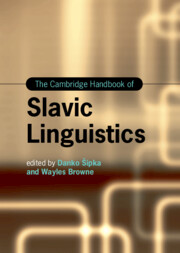Book contents
- The Cambridge Handbook of Slavic Linguistics
- Cambridge Handbooks in Language and Linguistics
- The Cambridge Handbook of Slavic Linguistics
- Copyright page
- Contents
- Figures
- Tables
- Contributors
- Introduction
- Part 1 Prosody and Phonology
- Part 2 Inflectional and Derivational Morphology
- Part 3 Syntax
- Part 4 Lexicon
- 23 The Structure of the Lexicon
- 24 Lexical Semantics
- 25 Lexical Borrowing
- Part 5 Sociolinguistic and Geographical Approaches
- Part 6 Experimental and Quantitative Approaches
- Name Index
- Subject Index
- References
24 - Lexical Semantics
Insights from Lexicology
from Part 4 - Lexicon
Published online by Cambridge University Press: 16 May 2024
- The Cambridge Handbook of Slavic Linguistics
- Cambridge Handbooks in Language and Linguistics
- The Cambridge Handbook of Slavic Linguistics
- Copyright page
- Contents
- Figures
- Tables
- Contributors
- Introduction
- Part 1 Prosody and Phonology
- Part 2 Inflectional and Derivational Morphology
- Part 3 Syntax
- Part 4 Lexicon
- 23 The Structure of the Lexicon
- 24 Lexical Semantics
- 25 Lexical Borrowing
- Part 5 Sociolinguistic and Geographical Approaches
- Part 6 Experimental and Quantitative Approaches
- Name Index
- Subject Index
- References
Summary
The chapter opens with an overview of basic categories within the field of study of lexical semantics. It next presents fundamental concepts related to the lexicon, especially the lexeme as the basic unit of lexicology. It also analyzes the concept of lexical meaning and provides a brief overview of some of the approaches adopted in the study of denotation and connotation. The central part of the chapter describes polysemy and its basic mechanisms – metaphor, metonymy, synecdoche. The examples feature Serbian and other Slavic lexemes exhibiting the richest polysemy. The next section tackles syntagmatic lexical relations, the notion of collocation and the role of context in the study of lexical meaning. Paradigmatic lexical relations are also observed, especially synonymy and antonymy, both true and contextual or quasi-.
Keywords
- Type
- Chapter
- Information
- The Cambridge Handbook of Slavic Linguistics , pp. 529 - 544Publisher: Cambridge University PressPrint publication year: 2024

